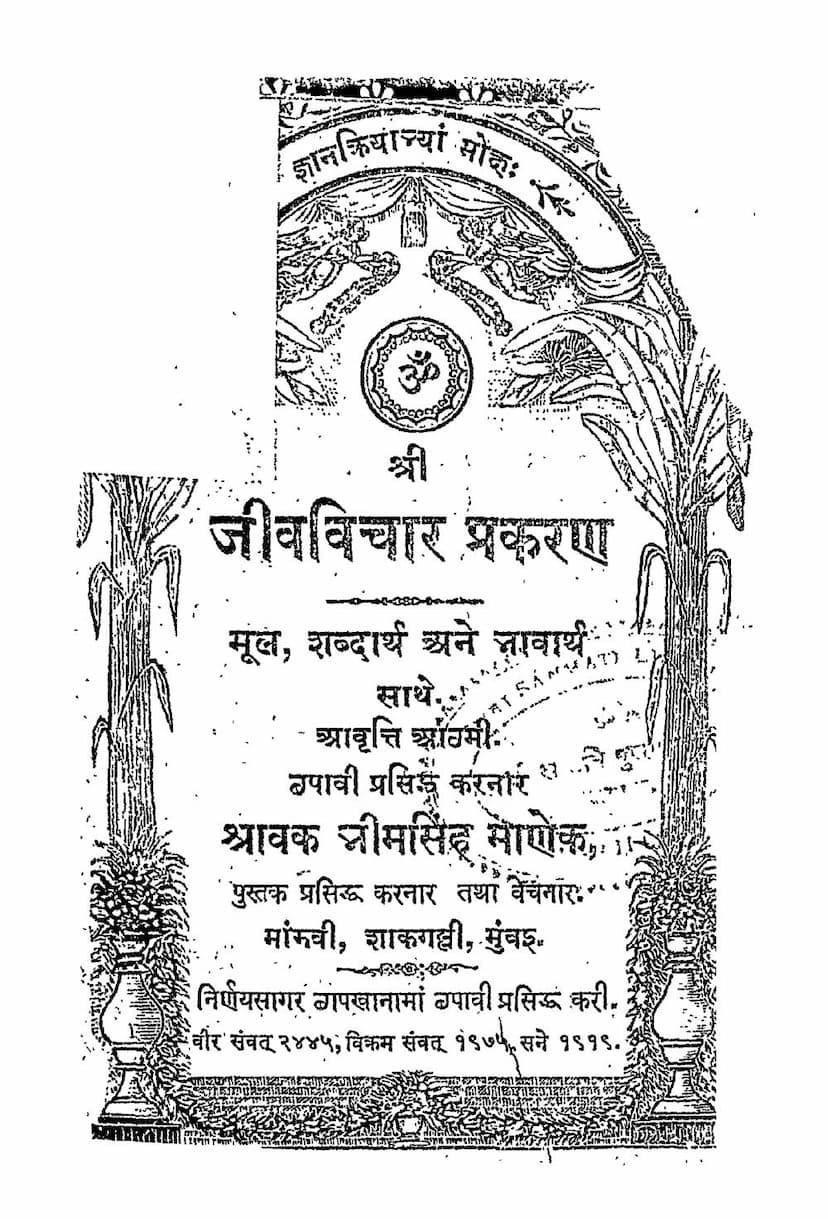Jiva Vichar Prakaran
Added to library: September 2, 2025

Summary
Here's a comprehensive summary of the Jain text "Jiva Vichar Prakaran" by Shravak Bhimsinh Manek, based on the provided pages:
Book Title: Jiva Vichar Prakaran (Treatise on the Soul) Author: Shravak Bhimsinh Manek Publisher: Shravak Bhimsinh Manek Catalog Link: https://jainqq.org/explore/010850/1
Overall Purpose: The "Jiva Vichar Prakaran" is a Jain text that systematically explains the different categories and characteristics of living beings (Jivas) according to Jain philosophy. It is written in Gujarati with explanations and Marathi commentary, aiming to provide a clear understanding of the Jiva Tattva (principle of the soul) for the benefit of spiritual seekers.
Key Concepts and Structure:
The text begins with a prologue and mangalacharan (auspicious invocation) by the author, who pays homage to Lord Mahavir and the ancient scholars. The author states the purpose of the book is to provide knowledge about the nature of the soul, following the tradition of previous saints.
The book then delves into the classification of Jivas, which is the core of the text. The primary division is into Samsari Jiva (worldly souls) and Mukta Jiva (liberated souls).
1. Samsari Jivas (Worldly Souls): These souls are further classified based on their sensory capabilities and modes of existence.
-
A. Sthavar Jiva (Stationary Souls): These are souls with only one sense (touch) and are immobile. They are divided into five categories:
- Prithvi Kay Jiva (Earth-bodied souls): Various types of earth, gems, metals, minerals, salt, etc., are mentioned as examples.
- Ap Kay Jiva (Water-bodied souls): Different forms of water, including rain water, dew, snow, ice, etc.
- Tej Kay Jiva (Fire-bodied souls): Various manifestations of fire, such as embers, flames, lightning, etc.
- Vayu Kay Jiva (Air-bodied souls): Different types of air currents, including updrafts, downdrafts, whirlwinds, strong winds, and gentle winds.
- Vanaspatikay Jiva (Plant-bodied souls): This is a major category, further divided into:
- Sadharan Vanaspati (Common Plants): Souls that inhabit a single body containing countless individual souls (like roots, stems, leaves of certain plants). Examples include various tubers, sprouts, leaves, algae, fungi, etc.
- Pratyek Vanaspati (Individual Plants): Souls that inhabit a body with only one individual soul. Examples include fruits, flowers, bark, wood, roots, leaves, and seeds where each part has a single soul.
-
B. Tras Jiva (Mobile Souls): These souls have more than one sense.
- Dvi-indriya (Two-sensed souls): Possessing the senses of touch and taste. Examples include conches, snails, worms, etc.
- Tri-indriya (Three-sensed souls): Possessing touch, taste, and smell. Examples include ants, lice, termites, etc.
- Chaur-indriya (Four-sensed souls): Possessing touch, taste, smell, and sight. Examples include flies, mosquitoes, bees, scorpions, etc.
- Panch-indriya (Five-sensed souls): Possessing all five senses (touch, taste, smell, sight, and hearing). These are further divided into:
- Narak Jiva (Hell-dwelling beings): Categorized by the seven hells and their respective strata.
- Tiriyanch (Animals/Sub-human beings): Classified as aquatic (jalchar), terrestrial (thalchar), and aerial (khaychar). This includes a wide array of creatures like fish, tortoises, snakes, insects, birds, etc., with details on their body sizes and lifespans.
- Manushya (Human beings): Described in terms of their birthplaces (Karma Bhumi, Akarma Bhumi, Antar Deep), lifespans, and physical characteristics. Different categories of humans based on their birth locations and the nature of their existence are explained.
- Deva Jiva (Celestial beings): Divided into four classes:
- Navanpati Devas: Ten types of celestial beings residing in lower heavens.
- Vyanter & Vanvayantar Devas: Eight types of beings residing in the middle regions.
- Jyotishki Devas: Celestial bodies like the Sun, Moon, planets, and stars.
- Vaimanika Devas: Souls residing in the highest heavens, further divided into Kalpopapanna (those born by rites) and Kalpatit (those born without specific rites, like Graiveyak and Anuttar Viman residents).
2. Mukta Jiva (Liberated Souls): These are souls that have completely shed their karmic bonds and attained liberation (Moksha). The text mentions that there are fifteen types of liberated souls, including Tirthankaras and other Siddhas.
Key Aspects Covered:
- Body Size (Sharir Man): The text details the physical dimensions of various Jivas, from the infinitesimally small souls of Sthavar beings to the colossal forms of certain celestial beings and animals.
- Lifespan (Aayu): The text specifies the maximum lifespans for different categories of Jivas, ranging from the extremely short lifespan of some micro-organisms to the immense lifespans of celestial beings and hell-dwellers.
- Continuity of Existence (Kay Sthiti): This section explains how souls of different categories are reborn within the same or different realms, and their cyclical existence. It is noted that celestial beings and hell-dwellers have a more fixed cycle of rebirth within their respective realms, while human and animal souls have more variations.
- Life-Generating Principles (Prana): The text enumerates the ten life-sustaining principles (senses, mind, speech, body, lifespan, breath) and how they are distributed among different classes of Jivas.
- Life Forms (Yoni): The text describes the vast number of "yonis" (life-forms or birth-categories) that Jivas go through in their cycle of rebirth, mentioning that there are 8.4 million such yonis.
- Consciousness and Attributes: The text implicitly discusses the presence of consciousness and the development of senses as a progression through different Jiva categories.
- The Goal of Liberation: While detailing the worldly existence of souls, the text implicitly points towards the ultimate goal of shedding karma to achieve liberation, as exemplified by the Mukta Jivas.
Author's Approach: Shravak Bhimsinh Manek presents this complex information in a structured and accessible manner, breaking down the vast classifications of Jivas into understandable categories. The use of Gujarati with commentary in a related language (likely Marathi) makes the spiritual knowledge available to a wider audience. The book is presented as a summary derived from fundamental Jain scriptures.
In essence, "Jiva Vichar Prakaran" is a foundational Jain text that provides a comprehensive ontological classification of all living beings, detailing their existence, form, lifespan, and the cyclical nature of their transmigration, all within the framework of Jain philosophy and ethics.